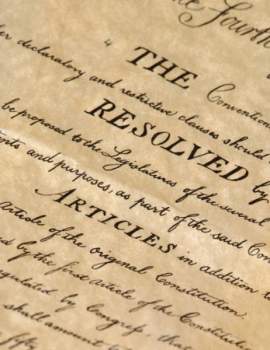
Racial Discrimination At A Glance

Popular In Constitution
Purpose Of Lifetime Appointment And Pros And Cons Enumerated Powers Bicameral Legislature Background Article 3 Of The Constitution We The People 1st Amendment Who Wrote The Constitution Judicial Review Equal Protection Clause Three Fifths Compromise 10th Amendment 5th Amendment
Racial discrimination is that alternate treatment of individuals solely on the basis of race. In reference to such a major issue, we may reference that of the Fourteenth Amendment. The first area of interest within this Amendment is that of the "Equal Protection Clause".
One of the most significant aspects of this Clause is the intent towards equal voting rights. One such Supreme Court case that references this clause was that of Reynolds v. Sims, which stated that it deemed the Equal Protection Clause as maintaining requirements for states to possess equal amounts in accordance with their individual districts as well as seats within Congress. Such Court cases aimed to do away with practices that attempted to devalue votes due to race.
The Civil Rights Act of 1875 also represented a venue by which racial discrimination may be combated. This statute set forth that every individual despite race, culture, or color of skin, may incur all the rights and public treatments that every citizen was entitled to.
Despite its being held as unconstitutional, a subsequent Civil Rights Act of 1964 presented an equally important and substantial aspect of legislation to combat racial discrimination. It specified that inequality within voting guidelines as well as within schools was illegal. A number of Titles are set forth within this Act. Under each, we see the following qualifications. Aside from voting practices as well as inequality within schools, other public facilities were additionally included. Government agencies existing under the funding of the Government were also at risk of losing such funding due to discriminatory practices.
Arising from the institution of legislature to halt racial discrimination is that of "affirmative action" within the United States. This term entails the equality that must exist in terms of employment as well as education. Ways in which employers must institute such a system include that of modifications made to their recruitment procedures as well as that of their practices of reaching out to the general public.
It hasn't gone without some kind of controversy, however, especially in relation to that of university admissions. Some reside within the belief that such practices as affirmative action are actually leading to "reverse discrimination". This term means that discrimination actually is existent against the majority population. In this way, individuals may believe that they may be bypassed despite their eligibility. This presents a new accompaniment to that of the traditional forms of racial discrimination, yet may also represent the ways in which affirmative action itself may be discriminated against. Racial discrimination, whether by way of its practice or abolishment, continues to exist as a subject of much contention within a varied population of people.
NEXT: What Is Segregation




















